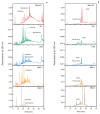Setting Up a "Green" Extraction Protocol for Bioactive Compounds in Buckwheat Husk
- PMID: 40806536
- PMCID: PMC12347780
- DOI: 10.3390/ijms26157407
Setting Up a "Green" Extraction Protocol for Bioactive Compounds in Buckwheat Husk
Abstract
Buckwheat, a gluten-free pseudocereal, is rich in dietary fiber, minerals, high-quality proteins, vitamins, and essential amino acids. Buckwheat husk, a by-product of dehulling, contains high levels of bioactive compounds such as polyphenols and dietary fibers. This study compares green extraction methods (ultrasound-assisted extraction, UAE; and microwave-assisted extraction, MAE) for recovering polyphenols from buckwheat husk. MAE improved polyphenol yield by 43.6% compared to conventional acidified methanol extraction. Structural and chemical analyses of the residual husk material using SEM, FTIR, and fiber analysis revealed that MAE alters husk properties, enhancing polyphenol accessibility. Thus, MAE appears an efficient and sustainable alternative to acid- and solvent-based extraction techniques. Extracts obtained via "green" methods retained strong antioxidant activity and showed significant modulation of inflammatory markers in human Caco-2 cells, highlighting the potential use of "green" buckwheat husk extracts for food and pharma applications. This work supports the valorization of buckwheat husk within a circular economy framework, promoting buckwheat husk as a valuable raw material for bioactive compound recovery in diverse applications.
Keywords: anti-inflammatory properties; buckwheat husk; extraction; microwave-assisted extraction; polyphenols; ultrasound-assisted extraction.
Conflict of interest statement
The authors declare no conflicts of interest. The funders had no role in the design of the study; in the collection, analyses, or interpretation of data; in the writing of the manuscript; or in the decision to publish the results.
Figures






Similar articles
-
Optimisation of Ultrasound-Assisted Extraction Conditions Using Response Surface Methodology and Identification of Thymoquinone from Black Cumin (Nigella sativa L.) Seed Extract§.Food Technol Biotechnol. 2025 Jun;63(2):262-273. doi: 10.17113/ftb.63.02.25.8560. Food Technol Biotechnol. 2025. PMID: 40735154 Free PMC article.
-
Enhancing Human Health Through Nutrient and Bioactive Compound Recovery from Agri-Food By-Products: A Decade of Progress.Nutrients. 2025 Jul 31;17(15):2528. doi: 10.3390/nu17152528. Nutrients. 2025. PMID: 40806112 Free PMC article. Review.
-
Sustainable Valorization of Olive Oil By-Products: Green Extraction of Phytochemicals, Encapsulation Strategies, and Food Applications.J Food Sci. 2025 Jul;90(7):e70412. doi: 10.1111/1750-3841.70412. J Food Sci. 2025. PMID: 40711829 Free PMC article. Review.
-
Green extraction of polyphenol compound from walnut green husk by microwave-assisted choline chloride-based deep eutectic solvents: identification, kinetic, comparison and bioactivity.Food Chem. 2025 Jul 5;492(Pt 2):145438. doi: 10.1016/j.foodchem.2025.145438. Online ahead of print. Food Chem. 2025. PMID: 40651140
-
Optimizing Chlorogenic Acid Extraction From Spent Coffee Grounds: A Comparative Review of Conventional and Non-Conventional Techniques.Food Sci Nutr. 2025 Jun 27;13(7):e70315. doi: 10.1002/fsn3.70315. eCollection 2025 Jul. Food Sci Nutr. 2025. PMID: 40585489 Free PMC article. Review.
References
-
- Wijngaard H.H., Arendt E.K. Buckwheat. Cereal Chem. 2006;83:391–401. doi: 10.1094/CC-83-0391. - DOI
-
- FAOSTAT Food and Agriculture Organization of the United Nations. [(accessed on 17 July 2025)]. Available online: https://www.fao.org/faostat/en/#data/QCL/visualize.
-
- Pocienė O., Šlinkšienė R. Studies on the Possibilities of Processing Buckwheat Husks and Ash in the Production of Environmentally Friendly Fertilizers. Agriculture. 2022;12:193. doi: 10.3390/agriculture12020193. - DOI
Grants and funding
LinkOut - more resources
Full Text Sources

